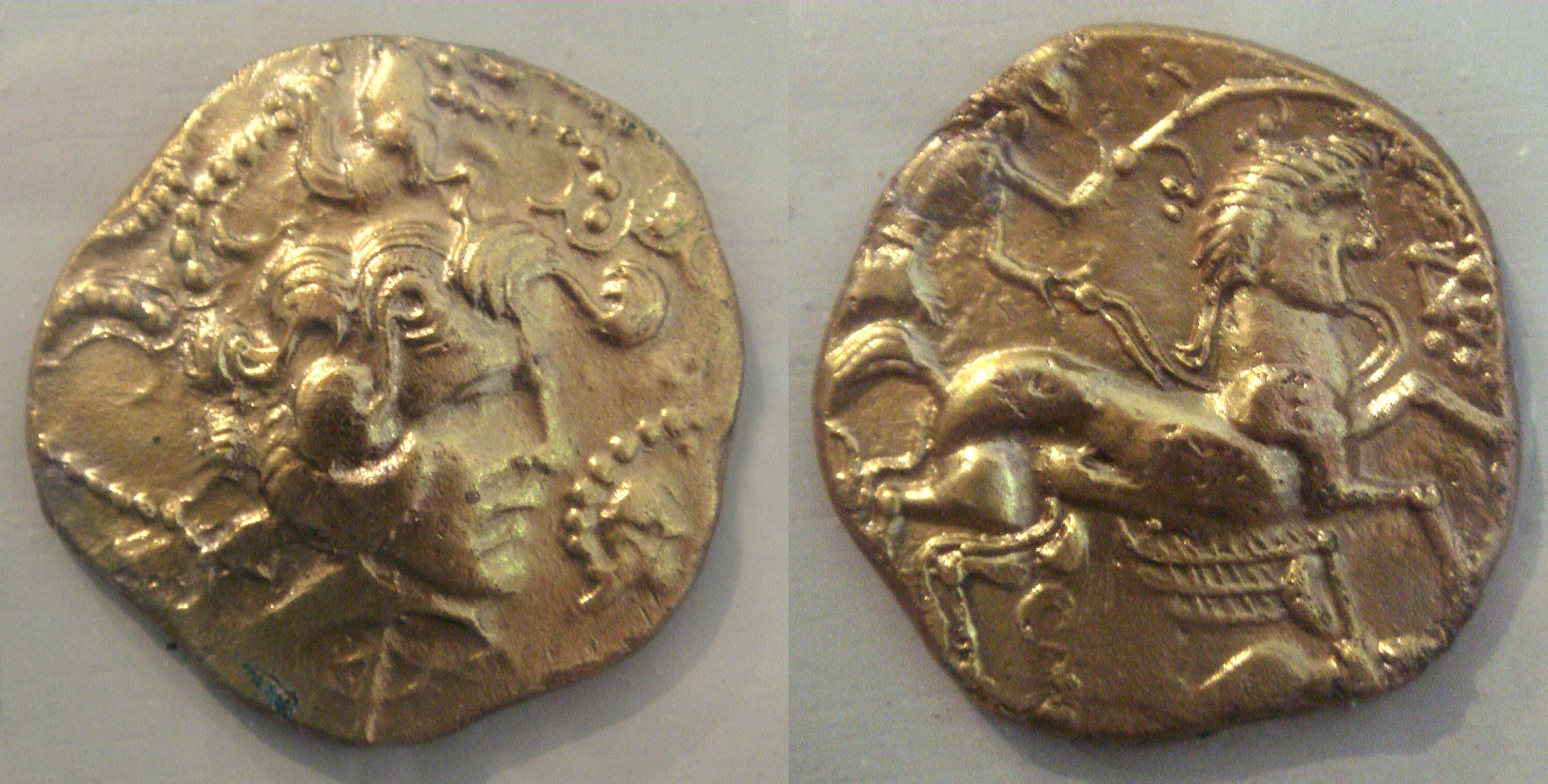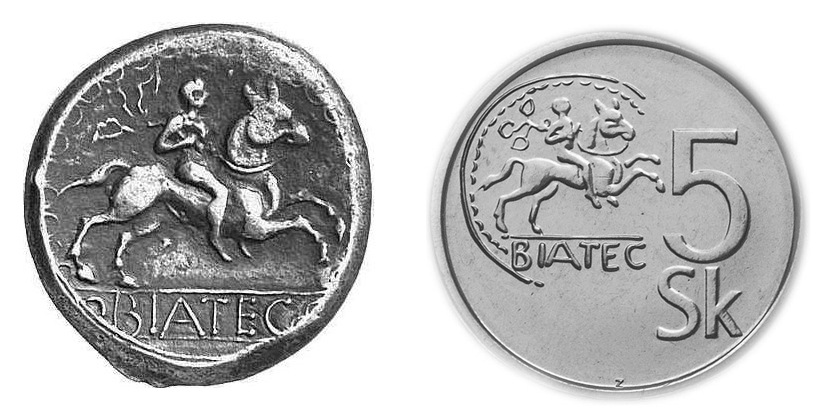Celtic Coins on:
[Wikipedia]
[Google]
[Amazon]
Celtic coinage was minted by the
/ref> Thus Greek motifs and even letters can be found on various Celtic coins, especially those of southern France.''Celtic Inscriptions on Gaulish and British Coins'' by Beale Poste p.13
/ref> The images found on Celtic coins include giants trailing severed heads on rope, horsemen charging into battle, gods and goddesses, skulls and chariot wheels, thunderbolts and lightning, the sun and the moon.

 Greek coinage occurred in three Greek cities of Marseille, Massalia, Emporiae and
Greek coinage occurred in three Greek cities of Marseille, Massalia, Emporiae and  The
The

 Traditional historians have tended to overlook the role played by Celtic coinage in the early history of British money.
Over 45,000 of the ancient British and Gaulish coins discovered in Britain have been recorded at the Oxford Celtic Coin Index. The Trinovantian tribal
Traditional historians have tended to overlook the role played by Celtic coinage in the early history of British money.
Over 45,000 of the ancient British and Gaulish coins discovered in Britain have been recorded at the Oxford Celtic Coin Index. The Trinovantian tribal
The Oxford Celtic Coin Index
{{Authority control
Celts
The Celts ( , see Names of the Celts#Pronunciation, pronunciation for different usages) or Celtic peoples ( ) were a collection of Indo-European languages, Indo-European peoples. "The Celts, an ancient Indo-European people, reached the apoge ...
from the late 4th century BC to the mid 1st century AD. Celtic coins were influenced by trade with and the supply of mercenaries to the Greeks, and initially copied Greek designs, especially Macedonian coins
The history of ancient Greek coinage can be divided (along with most other Greek art forms) into four periods: the Archaic Greece, Archaic, the Classical Greece, Classical, the Hellenistic Greece, Hellenistic and the Roman provincial currency, Ro ...
from the time of Philip II of Macedon
Philip II of Macedon (; 382 BC – October 336 BC) was the king (''basileus'') of the ancient kingdom of Macedonia (ancient kingdom), Macedonia from 359 BC until his death in 336 BC. He was a member of the Argead dynasty, founders of the ...
and his son, Alexander the Great
Alexander III of Macedon (; 20/21 July 356 BC – 10/11 June 323 BC), most commonly known as Alexander the Great, was a king of the Ancient Greece, ancient Greek kingdom of Macedonia (ancient kingdom), Macedon. He succeeded his father Philip ...
.
''Celtic culture: a historical encyclopedia'' John T. Koch p.461-/ref> Thus Greek motifs and even letters can be found on various Celtic coins, especially those of southern France.''Celtic Inscriptions on Gaulish and British Coins'' by Beale Poste p.13
/ref> The images found on Celtic coins include giants trailing severed heads on rope, horsemen charging into battle, gods and goddesses, skulls and chariot wheels, thunderbolts and lightning, the sun and the moon.
Gaulish coinage

 Greek coinage occurred in three Greek cities of Marseille, Massalia, Emporiae and
Greek coinage occurred in three Greek cities of Marseille, Massalia, Emporiae and Rhoda
''Rhoda'' is an American sitcom television series created by James L. Brooks and Allan Burns starring Valerie Harper that originally aired on CBS for five seasons from September 9, 1974 to December 9, 1978. It was the first spin-off of ''The ...
, and was copied throughout southern Gaul.
Northern Gaulish coins were especially influenced by the coinage of Philip II of Macedon
Philip II of Macedon (; 382 BC – October 336 BC) was the king (''basileus'') of the ancient kingdom of Macedonia (ancient kingdom), Macedonia from 359 BC until his death in 336 BC. He was a member of the Argead dynasty, founders of the ...
and his famous son Alexander the Great
Alexander III of Macedon (; 20/21 July 356 BC – 10/11 June 323 BC), most commonly known as Alexander the Great, was a king of the Ancient Greece, ancient Greek kingdom of Macedonia (ancient kingdom), Macedon. He succeeded his father Philip ...
. Celtic coins often retained Greek subjects, such as the head of Apollo
Apollo is one of the Twelve Olympians, Olympian deities in Ancient Greek religion, ancient Greek and Ancient Roman religion, Roman religion and Greek mythology, Greek and Roman mythology. Apollo has been recognized as a god of archery, mu ...
on the obverse and two-horse chariot
A chariot is a type of vehicle similar to a cart, driven by a charioteer, usually using horses to provide rapid Propulsion, motive power. The oldest known chariots have been found in burials of the Sintashta culture in modern-day Chelyabinsk O ...
on the reverse of the gold stater
The stater (; ) was an ancient coin used in various regions of Greece. The term is also used for similar coins, imitating Greek staters, minted elsewhere in ancient Europe.
History
The stater, as a Greek silver currency, first as ingots, and ...
of Philip II, but developed their own style from that basis, allowing for the development of a Graeco-Celtic synthesis.
After this first period in which Celtic coins rather faithfully reproduced Greek types, designs started to become more symbolic, as exemplified by the coinage of the Parisii in the Belgic region of northern France.
The Armorica
In ancient times, Armorica or Aremorica (Gaulish: ; ; ) was a region of Gaul between the Seine and the Loire that includes the Brittany Peninsula, and much of historical Normandy.
Name
The name ''Armorica'' is a Latinized form of the Gauli ...
n Celtic style in northwestern Gaul also developed from Celtic designs from the Rhine
The Rhine ( ) is one of the List of rivers of Europe, major rivers in Europe. The river begins in the Swiss canton of Graubünden in the southeastern Swiss Alps. It forms part of the Swiss-Liechtenstein border, then part of the Austria–Swit ...
valley, themselves derived from earlier Greek prototypes such as the wine scroll and split palmette
The palmette is a motif in decorative art which, in its most characteristic expression, resembles the fan-shaped leaves of a palm tree. It has a far-reaching history, originating in ancient Egypt with a subsequent development through the art o ...
.
 The
The Boii
The Boii (Latin language, Latin plural, singular ''Boius''; ) were a Celts, Celtic tribe of the later Iron Age, attested at various times in Cisalpine Gaul (present-day Northern Italy), Pannonia (present-day Austria and Hungary), present-day Ba ...
gave their name to Bohemia and Bologna; a Celtic coin (Biatec
Biatec was the name of a person, presumably a king, who appeared on the Celtic coins minted by the Boii in Bratislava (the capital of Slovakia) in the 1st century BC. The word Biatec (or Biatex) is also used as the name of those coins. In the li ...
) from Bratislava
Bratislava (German: ''Pressburg'', Hungarian: ''Pozsony'') is the Capital city, capital and largest city of the Slovakia, Slovak Republic and the fourth largest of all List of cities and towns on the river Danube, cities on the river Danube. ...
's mint is displayed on a Slovak 5 koruna coin, which was in use until Slovakia joined the euro zone on January 1, 2009.
A tribe of Celts called Eburones
The Eburones ( Greek: ) were a Gaulish- Germanic tribe dwelling in the northeast of Gaul, who lived north of the Ardennes in the region near what is now the southern Netherlands, eastern Belgium and the German Rhineland, in the period immediately ...
minted gold coins with triple spirals (a Celtic good luck symbol) on the front, and horses on the back.
The coins were either 'struck' or 'cast'. Both methods required a substantial degree of knowledge. Striking a blank coin formed in a clay mould was one way. After forming the blank, it would have been flattened out before striking with a die made from iron or bronze. The tiny details engraved on dies were just a few millimeters in diameter. Casting a coin required a different technique. They were produced by pouring molten alloy into a set of molds which were broken apart when the metal had cooled.
With the Roman invasion of Gaul, Greek-inspired Celtic coinage started to incorporate Roman influence instead, until it disappeared to be completely replaced by Roman coinage.
British Celtic coinage

 Traditional historians have tended to overlook the role played by Celtic coinage in the early history of British money.
Over 45,000 of the ancient British and Gaulish coins discovered in Britain have been recorded at the Oxford Celtic Coin Index. The Trinovantian tribal
Traditional historians have tended to overlook the role played by Celtic coinage in the early history of British money.
Over 45,000 of the ancient British and Gaulish coins discovered in Britain have been recorded at the Oxford Celtic Coin Index. The Trinovantian tribal oppidum
An ''oppidum'' (: ''oppida'') is a large fortified Iron Age Europe, Iron Age settlement or town. ''Oppida'' are primarily associated with the Celts, Celtic late La Tène culture, emerging during the 2nd and 1st centuries BC, spread acros ...
of Camulodunum
Camulodunum ( ; ), the Roman Empire, Ancient Roman name for what is now Colchester in Essex, was an important Castra, castrum and city in Roman Britain, and the first capital of the province. A temporary "wikt:strapline, strapline" in the 1960s ...
(modern Colchester
Colchester ( ) is a city in northeastern Essex, England. It is the second-largest settlement in the county, with a population of 130,245 at the 2021 United Kingdom census, 2021 Census. The demonym is ''Colcestrian''.
Colchester occupies the ...
) was minting large numbers of coins in the first centuries BC and AD, which have been found across Southern Britain.Crummy, Philip (1997) City of Victory; the story of Colchester - Britain's first Roman town. Published by Colchester Archaeological Trust () Common motifs on the Camulodunon coins included horses and wheat/barley sheafs,Crummy, Philip (1987) The Coins as Dating Evidence. In Crummy, N. (ed.) Colchester Archaeological Report 4: The Coins from Excavations in Colchester 1971-9. Published by Colchester Archaeological Trust with the names of the rulers usually in Latin script, or more rarely in Greek.
Notes
References
* Boardman, John ''The Diffusion of Classical Art in Antiquity'', Princeton 1993External links
The Oxford Celtic Coin Index
{{Authority control
Coinage
Coinage may refer to:
* Coins, standardized as currency
* Coining (mint), the process of manufacturing coins
* '' COINage'', a numismatics magazine
* Tin coinage, a tax on refined tin
* Coinage, a protologism or neologism
In linguistics, a neolo ...
Coins
A coin is a small object, usually round and flat, used primarily as a medium of exchange or legal tender. They are standardized in weight, and produced in large quantities at a mint in order to facilitate trade. They are most often issued by ...
Coins
Coinage
Coinage may refer to:
* Coins, standardized as currency
* Coining (mint), the process of manufacturing coins
* '' COINage'', a numismatics magazine
* Tin coinage, a tax on refined tin
* Coinage, a protologism or neologism
In linguistics, a neolo ...